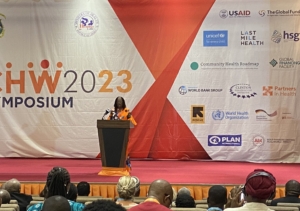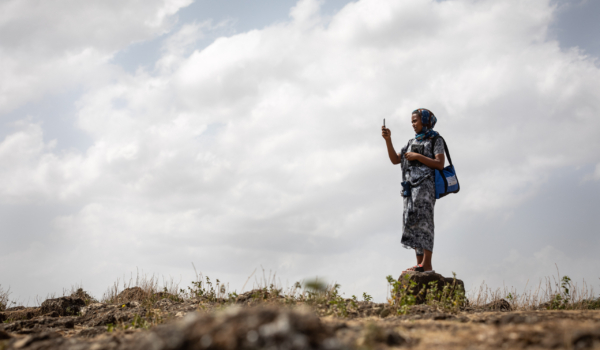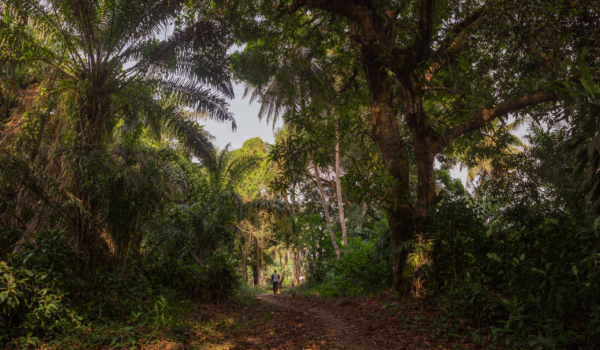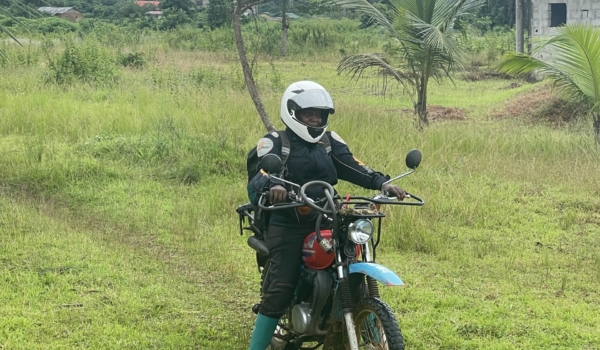March 24, 2023 – On the final day of the 3rd International Community Health Workforce Symposium in Monrovia, Liberia, Minister of Health Dr. Wilhemina Jallah announced the Monrovia Call to Action.
The Monrovia Call to Action
For investing in community health programs as an integral path to universal health coverage.

Dr. Wilhemina Jallah speaks at 2023 CHW Symposium in Liberia, Monrovia. March 2023.
We, the delegates of the 3rd International Symposium on Community Health Workers (CHWs) gathered by the Government of Liberia from 22 to 24 March 2023, inspired by progress of the exemplary Liberian National Community Health Program, reinforce our mutual commitment to fund, scale, and strengthen community health programs as an integral part of primary health care for the realization of universal health coverage.
We recognize:
- That CHWs1 deliver primary health care, improve health outcomes and save lives.2
- Community health is the equity arm of primary health care, and that CHWs are leaders in providing an integrated package of services including in emerging areas, like non-communicable diseases and mental health.3
- CHWs are essential to achieve global health security and play a critical role in pandemic preparedness and emergency response while helping to allay the health and economic shocks that follow.4
- Investing in a professional community health workforce can produce a 10 to 1 return on every dollar invested as a result of healthier populations, increased productivity, and job creation, in particular for women.5 This is a ‘public good’ that should be financed from public dollars.
- That addressing the health workforce challenge is essential for progress towards all health-related sustainable development goals, universal health coverage, pandemic preparedness and response, and reducing the impacts of climate change.
- To be fully effective, CHWs need to be skilled, supervised, paid a living wage, and supplied by a well-functioning primary health care system coordinated at scale and integrated into broader public systems via data and financing.6
We are urgently concerned that:
- Domestic resource allocation to the health sector remains insufficient to meet the Abuja targets.7 Fragmented and insufficient donor funding has worsened this situation.
- The global shortage of human resources for health is projected to be 43 million health workers by 2030.8
- Recent public health threats like Ebola and COVID-19 spread in part due to weak primary health systems that were not equipped to prevent, detect, and respond to outbreaks.4
- Over half of CHWs in low and middle income countries are unpaid.9 CHWs are out of stock of key commodities ⅓ of the time.10 Many receive inconsistent supervision and continuous medical education is rarely available.6 The failure to treat CHWs like professionals limits their ability to perform like professionals.11 The majority of CHWs globally are women and that women face barriers in accessing safe and decent work and leadership opportunities.12
- Despite advances in healthcare systems, more than 800 million people lack access to healthcare and 54 countries are off track to reach SDG 3.13
We call on the highest level of leadership including Heads of State, Ministers of Health, Ministers of Finance, and other line Ministries, the African Union, Africa CDC, bilateral and multilateral partners, the United Nations system, civil society, and the private sector, to:
- Invest in country-led community health strategies. Coordinate funding toward clear, costed, and prioritized national and sub-national community health strategies. Include core indicators on access, equity, and quality of an essential package of health services. Appropriately and incrementally increase domestic budget allocations and private sector financing for primary health care and CHWs, while decreasing out-of-pocket spending for patients. With recognition of the contributions CHWs make to disease-specific outcomes, affirm an integrated approach to service delivery.
- Make professional CHWs the norm. In line with the WHO Guidelines,6 ensure a cadre of CHWs is formalized, paid a fair wage, skilled, supervised, and supplied to deliver the highest quality care, and offered opportunities for career progression. This must be a just transition, undertaken with consideration for gender equity and social inclusion, to protect quality jobs for women and other marginalized groups. As valued workers, CHWs must be protected from health risks, violence, and sexual harassment.
- Integrate CHWs into human resource and health sector plans. Recognize CHWs as a core part of strong primary health care systems. This starts with counting and accrediting CHWs at national and subnational levels and mapping coverage. CHWs must be included in health sector planning including national disease strategies, implementation, technology, governance, and program monitoring. CHWs themselves, including female CHWs, must be included in decision making.
- Galvanize political support. Continue positioning community health on the political agenda, cultivate champions and key influencers, and develop investment cases to elevate the community health agenda at global, regional, and national levels.
- Track progress of CHW programs. Adopt an accountability framework ratified by countries in consultation with stakeholders including milestones, shared indicators, transparent investments by funding partners, and gender disaggregated data.
The evidence is clear. Protected, paid, trained, supervised, and supplied CHWs must be the rule and not the exception. As the CHWs of Liberia have repeatedly noted, “We are here for change.” The time to act is now. We must urgently fund, scale, and strengthen community health programs for the realization of universal health coverage and global health security.
References
- International Labour Organization. Updating the international standard classification of occupations (ISCO) draft ISCO-08 group definitions: Occupations in health [Internet]. [cited 2023 March 23]. Available from: https://www.ilo.org/public/english/bureau/stat/isco/docs/health.pdf
- Black, R. E., Taylor, C. E., Arole, S., Bang, A., Bhutta, Z. A., Chowdhury, A. M. R., Kirkwood, B. R., Kureshy, N., Lanata, C. F., Phillips, J. F., Taylor, M., Victora, C. G., Zhu, Z., & Perry, H. B. (2017). Comprehensive review of the evidence regarding the effectiveness of community-based primary health care in improving maternal, neonatal and child health: 8. summary and recommendations of the Expert Panel. Journal of global health, 7(1), 010908. https://doi.org/10.7189/jogh.07.010908
- Scott, K., Beckham, S. W., Gross, M., Pariyo, G., Rao, K. D., Cometto, G., & Perry, H. B. (2018). What do we know about community-based health worker programs? A systematic review of existing reviews on community health workers. Human resources for health, 16(1), 1-17.
- Sirleaf, E. J., & Clark, H. (2021). Report of the Independent Panel for Pandemic Preparedness and Response: making COVID-19 the last pandemic. The Lancet, 398(10295), 101-103.
- Dahn B, Woldemariam AT, Perry H, et al. Strengthening primary health care through community health workers: Investment case and financing recommendations. [cited 2023 March 21]. Available from: https://chwcentral.org/wp-content/uploads/2015/09/CHW-Financing-FINAL-July-15-2015.pdf
- Cometto, G., Ford, N., Pfaffman-Zambruni, J., Akl, E. A., Lehmann, U., McPake, B., … & Taylor, D. (2018). Health policy and system support to optimise community health worker programmes: an abridged WHO guideline. The Lancet Global Health, 6(12), e1397-e1404.
- WHO. Global health expenditure database [Internet]. [cited 2023 March 23]. Available from: https://apps.who.int/nha/database/ViewData/Indicators/en
- Haakenstad, A., Irvine, C. M. S., Knight, M., Bintz, C., Aravkin, A. Y., Zheng, P., … & Sahu, M. (2022). Measuring the availability of human resources for health and its relationship to universal health coverage for 204 countries and territories from 1990 to 2019: a systematic analysis for the Global Burden of Disease Study 2019. The Lancet, 399(10341), 2129-2154.
- Ballard, M., Odera, M., Bhatt, S., Geoffrey, B., Westgate, C., & Johnson, A. (2022). Payment of community health workers. The Lancet Global Health, 10(9), e1242.
- Olaniran A, Briggs J, Pradhan A, Bogue E, Schreiber B, Dini HS, Hurkchand H, Ballard M. Stock-outs of essential medicines among community health workers (CHWs) in low- and middle-income countries (LMICs): A systematic literature review of the extent, reasons, and consequences. Human Resources for Health. 2022 Jul 15; 20(1):58. Available from: https://doi.org/10.1186/s12960-022-00755-8
- Hazel E, Bryce J, The IIP-JHU iCCM Evaluation Working Group. On bathwater, babies, and designing programs for impact: evaluations of the integrated community case management strategy in Burkina Faso, Ethiopia, and Malawi. Am J Trop Med Hyg. 2016 Mar; 94(3):568-570.
- Boniol, M., McIsaac, M., Xu, L., Wuliji, T., Diallo, K., & Campbell, J. (2019). Gender equity in the health workforce: analysis of 104 countries (No. WHO/HIS/HWF/Gender/WP1/2019.1). World Health Organization.
- WHO. Tracking universal health coverage: 2021 Global monitoring report [Internet]. 2021 [cited 2023 March 23]. Available from: https://www.who.int/publications/i/item/978924004061
- Decision of the Twenty-Ninth Ordinary Session of the African Union Heads of States and Government (Assembly/AU/Dec.649 (XXIX) endorsing the 2 million (2M) Community Health Workers (CHWs) initiative, June 2017. https://au.int/sites/default/files/decisions/37294-assembly_au_dec_642_-_664_xxix_e_1.pdf




